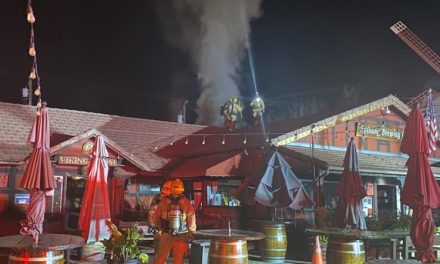By Giana Magnoli
Noozhawk Managing Editor
The Santa Barbara County Board of Supervisors voted July 9 to further restrict cannabis cultivation on agriculturally zoned land in Santa Barbara County, and the hours of public comment at the meeting pushed further discussion of ordinance changes to the following week.
On July 16, the board pushed forward more changes to the county’s cannabis ordinances, including earlier requirements for odor control and efforts to speed up the permit-application review process.
The supervisors spent several hours deliberating that day. They gave direction to county staff, but the specific ordinance changes will come back for final action at a future meeting.
At the marathon July 9 meeting, crowds of county residents packed the Board of Supervisors hearing rooms in Santa Maria and Santa Barbara, and more than 200 people spoke during the public comment period.
The supervisors voted to ban cannabis cultivation on AG-1-zoned properties that have a parcel size of 20 acres or less and to require conditional use permits (instead of land use permits) for operations on larger AG-1-zoned lots in inland areas.
The vote was 4-1, with Fifth District Supervisor Steve Lavagnino dissenting. The supervisors voted unanimously to require more noticing for cannabis operations proposed in or near Existing Developed Rural Neighborhoods and other residential neighborhoods.
The board had planned to give direction on other possible changes, such as requiring odor control as a condition of a business license application, but pushed the discussion to the next week’s meeting after a power outage pushed the gathering into a smaller room in the Joseph Centeno Betteravia Government Administration Building.
County staff broadcast the last of the public comment via Facebook Live, and the board adjourned at 7:10 p.m.
The speakers included community members from all over the county, people working in the cannabis industry, and representatives from the cities of Carpinteria, Goleta, Solvang and Lompoc.
While many people say they want mostly the same thing — to allow responsible, compatible operators and to shut down the rest — there’s disagreement about what that means and how to do that.
County supervisors and staff have been preaching patience, saying that many of the nuisance complaints, such as odor, will be solved by permit requirements. However, there are dozens of operations growing without permits and therefore without such requirements, and neighbors are beyond frustrated.
Goleta Mayor Paula Perotte said that the amendments to require CUPs and expand noticing are steps in the right direction but don’t go far enough. She asked for a 1-mile buffer from cannabis cultivations to urban areas.
Goleta residents aren’t convinced, given Carpinteria’s experience, that concerns of odor, traffic and visual impacts can be addressed with permits, she said.
Perotte said policies aren’t always done right the first time, and Goleta’s cannabis ordinance wasn’t: “We brought ours back and fixed it.”
Carpinteria Mayor Wade Nomura said the city is looking for a balance and wants CUPs required for cultivators on AG-1 land in the Coastal Zone as well as inland areas. He also asked the county to use buffers between growers to avoid concentration and to increase the buffer for sensitive receptors to 1,000 feet from property line to property line.
There are areas where marijuana growers are in direct proximity to schools and residents, and he said there needs to be a balance.
Jenelle Osborne, Lompoc’s mayor, said the city “embraced and normalized cannabis as quickly as possible,” deciding not to cap permits and to let the free market regulate the industry size. She urged the Board of Supervisors not to make “midstream changes” for an industry making an effort to be legal and regulated.
The supervisors didn’t deliberate much on these issues since they’ve discussed them before and were mostly following the Planning Commission’s recommendations. The commissioners recommended applying the AG-1 limits to the Coastal Zone as well, but the changes apply only to inland areas.
Fourth District Supervisor Peter Adam said cannabis was the only example he could think of where people can do something and “backfill the rules later.” He said that he initially thought the ordinance was too restrictive, but he didn’t anticipate some of the consequences.
“I really wasn’t expecting this to be that big of a deal in reality,” Adam said, adding that he is concerned about the odors and the industry’s impact on other agriculture.
First District Supervisor Das Williams said requiring CUPs would slow down the permitting process and prolong nuisances, but he voted to support the ordinance amendment.
“We should be permitting the best and shutting down the ones that can’t adhere to our rules and cause a nuisance,” he said.
He said he is concerned about odor but is more concerned about local school districts having enough property taxes to avoid cutting staffing.
He and Lavagnino both commented in response to a recent Los Angeles Times article about the proliferating Santa Barbara County cannabis industry, which has the most provisional state licenses of any county in California — about 670 as of early July.
The article specifically called out Lavagnino and Williams, who were on the subcommittee to work on the ordinance before bringing it to the full Board of Supervisors. Lavagnino said he expects to get criticism, but not to be accused of being unethical.
He said he accepted about $12,000 in campaign contributions from the cannabis industry, which was legal and did not violate any rules; he also met with growers and invited one to a Special Olympics fundraiser, as noted in the article.
“I meet with everybody,” he said. “If I haven’t met with you, you haven’t asked me.”
As to the ordinances, he said the county could continue living under a ban that didn’t work or use its regulations to put teeth into enforcement.
Lavagnino said it might be easier to abandon the plan, but that he would keep working on a solution for the ordinances since the county “has a critical need for revenue.”
People often turn out in opposition to reject revenue-generating projects that could help fund county programs, he said, referring to oil and gas development, short-term rentals, beach parking fees and cannabis.
“Why is it that this room and the Santa Barbara hearing room is usually populated by some of the wealthiest people in this county demanding that we not pursue revenue streams that provide services for the poorest members of our community?” he said.
Williams said he assured industry members and residents that he would work to fix the cannabis-related issues, and that it was part of the job to be accessible to everyone.
He also said he sometimes agreed with the cannabis industry on an idea but more often with ideas that residents had, such as the cap and ban on outdoor grows in Carpinteria.
Noozhawk managing editor Giana Magnoli can be reached at gmagnoli@noozhawk.com.





